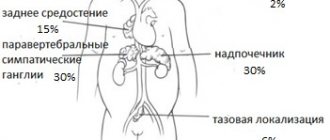Bronchial asthma is a chronic relapsing disease that primarily affects the respiratory tract. Characterized by altered bronchial reactivity. A mandatory sign of the disease is an attack of suffocation and status asthmaticus. In most cases, the onset of the disease occurs in childhood and adolescence. However, the disease can begin to develop at any age. To diagnose bronchial asthma, pulmonologists at the Yusupov Hospital conduct a comprehensive examination of patients using modern laboratory and instrumental research methods. Patients are advised by an immunologist-allergist.
If a patient develops broncho-obstructive syndrome for the first time in old age, pulmonologists at the Yusupov Hospital must carry out a differential diagnosis with a number of diseases similar in clinical course (chronic obstructive disease, pulmonary embolism, acute left ventricular failure, lung tumor). To make a diagnosis of bronchial asthma, doctors establish the connection between the appearance of symptoms of the disease after contact with an allergen, the combination with rhinitis, seasonal variability of symptoms, the presence of a genetic, hereditary predisposition to allergic reactions in close relatives and the patient.
Pulmonologists individually select medications to treat each patient. Therapy is carried out with drugs registered in the Russian Federation, which are effective and have a minimal range of side effects.
Bronchial asthma is characterized by:
- Increased or inadequate reaction of the bronchi (hyperreactivity) to the allergen;
- Excessive production of bronchial secretions;
- Chronic and protracted course;
- Recurrent (paroxysmal) nature;
- Shortness of breath;
- wheezing;
- Attacks of dry cough.
Despite numerous studies devoted to this topic, the problem of diagnosing and treating bronchial asthma remains relevant.
The true prevalence and incidence of asthma is difficult to estimate. This may well be due to the fact that different countries use certain diagnostic criteria that are specific only to this region. Rapid urbanization, environmental pollution, chemicalization of agriculture and the constant use of inorganic food additives have all led to a rapid increase in allergization of the world's population. To date, the highest incidence of bronchial asthma has been recorded in the USA, the Russian Federation and Australia. Treatment of bronchial asthma in Moscow is successfully carried out by specialists from the Yusupov Hospital Therapy Clinic. Experienced doctors with extensive experience use modern techniques for diagnosing and treating various diseases of the respiratory system. Thanks to close cooperation with European clinics and the exchange of experience, patients at the Yusupov Hospital Therapy Clinic have a unique opportunity to receive the most effective and safe medications for the treatment of bronchial asthma, which have minimal side effects on the body.
Make an appointment
The main reasons for the development of the disease
Bronchial asthma is a multifactorial disease, that is, it has different causes of development - both external and internal. Traditionally, asthma is believed to be caused by specific allergens:
- Food (honey, citrus fruits, nuts, legumes, seafood, eggs);
- Pollen;
- Fungal;
- Household (feather pillows, house and library dust);
- Animal fur;
- With pincers.
In order for hypersensitivity of the trachea and bronchi to occur, the amount of allergens during contact with them must be very large.
In the future, if the period of sensitization has passed, only a small part of the allergen is enough to trigger an attack of bronchial asthma. In second place after allergens are pharmacological agents:
- Non-steroidal anti-inflammatory drugs;
- Beta blockers;
- Various dyes;
- Aspirin is a classic drug that can provoke acute bronchospasm. A typical attack of aspirin asthma is combined with vasomotor rhinitis and rhinosinusitis.
Environmental factors also play an important role in the occurrence of asthma.
It is most often found in areas with developed heavy industry, high population density, dry climate, frequent temperature changes and stagnant air masses. The fourth reason for the development of AD is considered to be industrial waste. Bronchospasm can be caused by exposure to a variety of compounds used in industry:
- Salts of heavy metals (nickel, chromium, platinum);
- Wood and plant pollen (cedar, oak, cocoa);
- Polymers;
- Household chemicals;
- Various paints and solvents.
Physical activity can provoke the appearance of symptoms of bronchospasm and bronchial obstruction.
The mechanism of development for this type of bronchial asthma involves temperature changes that occur in the bronchi as a result of increased ventilation and subsequent cooling and dryness of the inhaled air. In addition, a well-known factor is that psycho-emotional lability can both aggravate and improve the patient’s condition. This is directly related to changes in the tone of the vagus nerve. The vagus nerve is responsible for the motor activity of the smooth muscles of the tracheobronchial tree.
Development mechanism
The general mechanism of development, which is inherent in different types of bronchial asthma, is a change in the sensitivity and reactivity of the bronchi, which is determined by the reaction of bronchial patency in response to the influence of pharmacological and physical factors.
In persons suffering from the atonic variant of bronchial asthma, the disease is of hereditary origin. Nonbacterial (plant pollen, house dust, animal hair, bird down and feathers) and bacterial (viruses, bacteria, fungi) allergens play a role in the occurrence of allergic forms of asthma. The mechanisms that underlie different types of inflammation are not well understood.
It is assumed that predominantly eosinophilic inflammation is associated with the activation of Th2 lymphocytes and their increased production of interleukins-5 and 13. Neutrophilic inflammation may be a consequence of the use of inhaled and systemic glucocorticosteroids. With an unexpressed inflammatory process, smooth muscles, fibroblasts and neurons of the respiratory tract play a leading role in the development and progression of the disease. The central role of immunoglobulins E in atopic asthma has been proven.
In bronchial asthma, remodeling of the airways occurs:
- Thickening of the basement membrane;
- Thickening and increase in the number of smooth muscles and goblet cells due to their excessive formation;
- Formation of new vessels.
This leads to irreversible changes in the ventilation function of the lungs and the appearance of ventilation defects. The central place in the mechanism of development of “aspirin” asthma is given to leukotrienes. In physical exertion asthma, heat transfer from the surface of the airways is disrupted.
Sources
- Franova S., Molitorisova M., Kazimierova I., Joskova M., Forsberg CIN., Novakova E., Sutovska M. Pharmacodynamic evaluation of dihydroxyflavone derivative chrysin in a guinea pig model of allergic asthma. // J Pharm Pharmacol - 2021 - Vol73 - N2 - p.233-240; PMID:33793800
- Winslow S., Odqvist L., Diver S., Riise R., Abdillahi S., Wingren C., Lindmark H., Wellner A., Lundin S., Yrlid L., Ax E., Djukanovic R., Sridhar S ., Higham A., Singh D., Southworth T., Brightling CE., Olsson HK., Jevnikar Z. Multi-omics links IL-6 trans-signalling with neutrophil extracellular trap formation and Haemophilus infection in COPD. // Eur Respir J - 2021 - Vol - NNULL - p.; PMID:33766947
- Motlagh AJ., Esmaelzadeh Saeieh S., Parhigar O., Salehi L. An asthmatic pregnant woman with COVID-19: A case report study. // Respir Med Case Rep - 2021 - Vol31 - NNULL - p.101296; PMID:33240787
- Lee DDH., Cardinale D., Terakosolphan W., Sornsute A., Radhakrishnan P., Coppel J., Smith CM., Satyanarayana S., Forbes B., O'Callaghan C. Fluticasone Particles Bind to Motile Respiratory Cilia: A Mechanism for Enhanced Lung and Systemic Exposure? // J Aerosol Med Pulm Drug Deliv - 2021 - Vol - NNULL - p.; PMID:32960118
- Jackson N.D., Everman JL., Chioccioli M., Feriani L., Goldfarbmuren KC., Sajuthi SP., Rios CL., Powell R., Armstrong M., Gomez J., Michel C., Eng C., Oh SS ., Rodriguez-Santana J., Cicuta P., Reisdorph N., Burchard EG., Seibold MA. Single-Cell and Population Transcriptomics Reveal Pan-epithelial Remodeling in Type 2-High Asthma. // Cell Rep - 2021 - Vol32 - N1 - p.107872; PMID:32640237
- Triantafillou V., Maina IW., Patel NN., Tong CCL., Papagiannopoulos P., Kohanski MA., Kennedy DW., Palmer JN., Adappa ND., Cohen NA., Bosso JV. In vitro safety of ketotifen as a topical nasal rinse. // Int Forum Allergy Rhinol - 2021 - Vol10 - N2 - p.265-270; PMID:32086998
- Basnet S., Bochkov YA., Brockman-Schneider RA., Kuipers I., Aesif SW., Jackson DJ., Lemanske RF., Ober C., Palmenberg AC., Gern JE. CDHR3 Asthma-Risk Genotype Affects Susceptibility of Airway Epithelium to Rhinovirus C Infections. // Am J Respir Cell Mol Biol - 2021 - Vol61 - N4 - p.450-458; PMID:30916989
- Satti R., Abid NU., Bottaro M., De Rui M., Garrido M., Raoufy MR., Montagnese S., Mani AR. The Application of the Extended Poincaré Plot in the Analysis of Physiological Variabilities. // Front Physiol - 2021 - Vol10 - NNULL - p.116; PMID:30837892
- Seibold MA. Interleukin-13 Stimulation Reveals the Cellular and Functional Plasticity of the Airway Epithelium. // Ann Am Thorac Soc - 2021 - Vol15 - NSuppl 2 - p.S98-S102; PMID:29676620
- Lindner K., Webering S., Stroebele M., Bockhorn H., Hansen T., König P., Fehrenbach H. Low Dose Carbon Black Nanoparticle Exposure Does Not Aggravate Allergic Airway Inflammation in Mice Irrespective of the Presence of Surface Polycyclic Aromatic Hydrocarbons . // Nanomaterials (Basel) - 2021 - Vol8 - N4 - p.; PMID:29614747
Modern classification of asthma
Thanks to an in-depth study of such a unique disease as bronchial asthma, many classifications of this pathology have been developed over time. For example, according to the International Classification of Diseases, Tenth Revision (ICD-10), the following forms of asthma are distinguished:
- Allergic asthma - in this case, the cause of the development of the disease is mainly allergic processes. As a rule, the allergen can be identified during additional diagnostic studies;
- Non-allergic asthma – the disease is not caused by allergic processes;
- Mixed asthma - in which both allergic and non-allergic irritants are combined;
- Unspecified asthma – the cause of the disease cannot be determined.
After doctors determine the type of asthma, they assess the severity of the patient's condition before starting treatment. For this purpose, classification by severity is used. It is based on four simple indicators:
- Frequency of daily exacerbation symptoms per day and per week;
- Frequency of nocturnal exacerbation symptoms per week;
- The impact of an exacerbation on the patient’s quality of life;
- The value of external respiration indicators (PSV and FEV1).
Bronchial asthma occurs in two stages.
The first stage, when symptoms appear from time to time, is called intermittent (episodic) asthma. The second stage, when symptoms are present for a long time or constantly, is called persistent (permanent) asthma. Depending on the severity of symptoms, this stage has three degrees of severity: mild, moderate and severe. Intermittent (episodic) asthma is characterized by short-term episodes of asthma attack, less than once a week. At night, attacks occur no more than twice a month (for at least three months). PEF and FEV1 > 80% of predicted value. Fluctuations in PEF during the day are less than 20%.
Persistent asthma (mild) is characterized by exacerbation of daytime and nighttime attacks (2 times a week). These episodes cause disturbances in sleep and activity. PEF corresponds to 60-80% of the predicted value. Fluctuations in PSV during the day are 20-30%.
Persistent asthma (moderate severity) is characterized by daily attacks of asthma. Nighttime symptoms occur once a week. These exacerbations gradually lead to limited physical activity and sleep disturbances. The patient requires daily use of inhaled medications (short-acting beta2-agonists). PSV - 60-80% of the required indicators. The daily fluctuation of the PSV value is more than 30%.
The persistent form (severe) is characterized by frequent nocturnal attacks, exacerbations, and a sharp limitation of physical activity. PSV
Make an appointment
Myth 5. Anti-asthma medications are addictive; the patient will no longer be able to live without them.
In fact.
In some variants of the individual course of asthma, a person is forced to use an inhaler for a long time, sometimes for life. But it’s not because he’s addicted to the drug, it’s not a drug. But because this is the essence of the disease. For some people, the course of treatment leads to months of remission, and they can stop taking medications for a while. For others, stopping the inhaler causes a deterioration, usually with nightly attacks of coughing and suffocation. They need constant medication in an optimal manner.
Also, do not be afraid of getting used to the medicine. This doesn't happen. It’s just that sometimes a person experiences an exacerbation, during which he needs to increase the dosage or complicate the treatment. But then the doctor reduces the drug load. And on the previous medications the person feels completely normal.
Symptoms
The clinical picture of bronchial asthma is described by three main symptoms:
- breathing disorder,
- coughing attacks,
- presence of distant wheezing.
In most cases, attacks occur at night.
Approximately 70% of asthma patients (without taking into account the form of the disease) wake up between one in the morning and five in the morning during an exacerbation episode. The reason for this is increased bronchospasm. This appears to be associated with increased vagal tone, levels of endogenous catecholamines (adrenaline, norepinephrine) and histamine. Histamine is a biologically active substance synthesized by the cells of the human body, which plays a huge role in the cascade of allergic reactions. So, bronchial asthma is characterized by the following manifestations:
- Development of respiratory distress;
- Shortness of breath;
- Heavy breathing;
- Inflating the wings of the nose;
- Cyanosis (blue discoloration of the skin due to low oxygen levels in the blood);
- Participation in the act of breathing of the auxiliary muscles of the chest;
- Excitement, excitement;
- Rapid heartbeat;
- Remote wheezing;
- Sweating.
Before the onset of asthma symptoms, so-called precursors appear.
A clinical picture of conjunctivitis, rhinitis or pharyngitis appears after contact with an allergen. After this, the patient begins to experience a feeling of constriction in the chest. Breathing becomes harsh and expiratory shortness of breath occurs. It is characterized by a rapid and intermittent inhalation, followed by a long, very difficult active exhalation (normally, exhalation is passive). The auxiliary muscles of the upper shoulder girdle and abdominal wall begin to participate in the act of breathing. To facilitate exhalation, the patient takes the most comfortable position for him with the torso tilted forward and emphasis on the hands to fix the shoulder girdle. The attack usually ends with a cough with the discharge of thick, glassy sputum. Often the first manifestation of bronchial asthma is a paroxysmal cough, which is accompanied by expiratory shortness of breath (difficulty exhaling) with the discharge of a small amount of glassy sputum. The developed clinical picture of bronchial asthma is characterized by the appearance of mild, moderate or severe attacks of suffocation. Sometimes an attack begins with the following warning signs:
- Copious discharge of watery secretion from the nose;
- Sneezing;
- Paroxysmal cough.
During an attack of bronchial asthma, the patient takes a short inhalation and an extended exhalation, which is accompanied by wheezing audible from a distance.
The chest is in the position of maximum inspiration. The muscles of the abdominal wall, back, and shoulder girdle take part in breathing. When percussing over the lungs, a box sound is detected; upon auscultation, many dry rales are heard. The attack ends with the release of viscous sputum. One of the most dangerous variants of the course of the disease is the asthmatic state, which can develop into a severe, protracted attack. The asthmatic condition is characterized by a nonproductive cough and increasing resistance to bronchodilator therapy. Pulmonologists distinguish anaphylactic and metabolic forms of the asthmatic condition.
In the anaphylactic form, which is caused by pseudo-allergic or immunological reactions with the release of a large number of mediators of the allergic reaction, an acute severe attack of suffocation occurs.
The metabolic form of bronchial asthma is associated with a functional blockade of beta-adrenergic receptors. It occurs as a result of exposure to adverse meteorological factors, overdose of sympathomimetics during respiratory tract infections, due to rapid withdrawal of corticosteroids, and forms within a few days. Initially, the patient stops producing sputum, and pain appears in the abdominal area, chest, and shoulder girdle muscles. Increased ventilation and loss of moisture with exhaled air lead to an increase in the viscosity of sputum and the closure of the bronchial lumen with a viscous secretion.
The second stage of bronchial status is characterized by the formation of “silent lung” areas in the posterior lower parts of the lungs. There is a clear discrepancy between the severity of distant wheezing and its absence when listening with a stethoscope. The condition of the patients is extremely serious. The chest is emphysematously distended. Pulse is more often than 120 per minute, blood pressure is increased. The ECG shows signs of overload in the right side of the heart. Patients develop respiratory or mixed acidosis (a shift in the body's acid-base balance towards increased acidity).
In the third stage (hypoxic-hypercapnic coma), shortness of breath and cyanosis (bluish color of the skin and visible mucous membranes) increase. The patient's sudden agitation is replaced by loss of consciousness, and convulsions may occur. The pulse is paradoxical (filling decreases during inspiration), blood pressure is reduced.
Patients with bronchial status are hospitalized in the intensive care unit on any day of the week, regardless of the time of day. They are observed by resuscitators using monitors and given therapy aimed at stopping an attack of bronchial asthma. Severe cases of bronchial status are discussed at a meeting of the Expert Council with the participation of candidates and doctors of medical sciences, doctors of the highest category. Leading specialists in the field of pulmonology, immunology and allergology develop patient management tactics. A multidisciplinary approach to the treatment of bronchial asthma allows you to quickly relieve the bronchial status and achieve sustainable remission.
The course of bronchial asthma is largely determined by the age of the patient at which the disease developed. In the vast majority of cases, signs of bronchial asthma in children disappear spontaneously at puberty.
Bronchial asthma in clear language. Frequently asked questions from colleagues and patients.
What is Bronchial Asthma (BA). Currently, a consensus of experts from different countries has defined asthma. The latest edition of GINA 2021 provides a definition of asthma without taking into account age characteristics. Asthma is “a heterogeneous disease usually characterized by chronic inflammation of the airways. Determined by a history of respiratory symptoms, such as wheezing, shortness of breath, chest tightness, cough, which are variable in time and intensity and are associated with reversible expiratory airflow limitation.”[1] In simple terms, repeated wheezing and coughing in the lungs that occurs for various reasons is called asthma.
A huge amount of work performed by various specialists has been devoted to the study of respiratory diseases. It is impossible to fully cover all the problems in a short article, but we will try to briefly highlight the latest ideas about bronchial asthma from the perspective of a practicing doctor who faces the problem every day. Pediatricians, allergists, pulmonologists and general practitioners treat asthma and view the problem from their own point of view. The main specialists dealing with the problem in children are allergists, because... asthma in pediatrics is almost always associated with allergies. In adulthood, the number of chronic diseases accumulates and often an additional pulmonologist is needed. In cases where a patient has several allergic diseases at the same time, an allergist specialist can take a comprehensive approach to the patient’s treatment and immediately prescribe the required amount of therapy and examination.
How common is asthma in Russia and in the world? According to various experts, bronchial asthma (BA) is the most common chronic lung disease in children in countries with a “Western” lifestyle and probably the second most common in adults after smoking-related chronic lung disease. According to estimates by the World Health Organization (WHO) and the Global Asthma Network, asthma affects up to 15-20% of the population in different countries [2]. The Russian Federation, according to official statistics and the Global Asthma Network, has a prevalence of asthma of ≈ 3%, which is about 4-5 million people in our country. Data on regional prevalence in the Russian Federation differ significantly. Since 1990, the incidence rate in the Russian Federation has decreased from 3719.74 to 2899.30 per 100,000 population in 2021[2].
Can you die from asthma? Unfortunately yes. Despite the efforts of various specialists, such cases still persist. Over the past 30 years, mortality has decreased significantly in all regions of the world, regardless of economic situation, and is about 250 - 300 thousand per year. Russia shows a good position in the ranking and mortality dynamics. Mortality rates have remained low over recent years and are comparable to countries in Europe and North America: from 1990 to 2021, mortality decreased from 4.93 to 1.23 per 100 thousand population.
We draw the attention of colleagues and patients! Disease severity and mortality are not associated. Mild patients who are not followed up have a similar chance of dying.
Among the main causes (risk factors) of mortality and hospitalization of the patient are:
- Lack of basic therapy, especially in cases where the attack is predictable (seasonal and virus-induced exacerbations);
- Lack of medications for emergency relief of bronchospasm in the patient, inability to provide self-help;
- An unclear plan of action for an exacerbation, lack of diagnosis, its disguise under the masks of “relapses of biofeedback”, “bronchitis with an asthmatic component”, etc.
- Isolated use of short-acting bronchodilators with the development of systemic undesirable effects (overdose).
Observation by a specialist, awareness of your disease and having medications on hand to provide assistance are the key to success in relieving an exacerbation.
If you have allergic rhinitis, will you definitely have asthma? In childhood, asthma often occurs after allergic rhinitis and allergic atopic dermatitis, the so-called “atopic march.” The chances of developing asthma increase if there are relatives in the family with an established diagnosis of asthma. Genes play a huge role in the health and development of many diseases, asthma is no exception, however, there are often situations when asthma occurs for the first time in adults and children who previously have no allergies or asthma in the family [3,4].
Is asthma forever? Bronchial asthma in children at the present stage cannot be considered as an isolated pulmonary disease caused by an allergy. The pathogenesis of asthma is based on immune inflammation, which often has unobvious causes. The modern concept of personalized medicine requires an individual approach to the patient. In adults, if asthma develops after age 40 or 50, symptoms are likely to persist for a very long time.
The topic of “childhood asthma” is more complicated, because asthma in children has a number of features that distinguish it in pathogenesis, course and prognosis. Due to the development of the immune system, asthma can have a wave-like course; symptoms may disappear almost completely during puberty and return later. Up to a third of patients report asthma in childhood and worsening in adulthood after many years without complaints or symptoms. Another option is that symptoms appear only during periods of maximum stress - during physical activity, a viral disease, or massive contact with an allergen [5–7].
Is there an allergy without asthma and asthma without an allergy?
Asthma is a heterogeneous disease. In recent years, it has been accepted that there are phenotypes—clinical variants of asthma.
The most common option is Allergic BA . It begins in childhood and is often combined with allergic rhinitis and atopic dermatitis in the patient and in the family. This phenotype is sometimes called early-onset (childhood-onset) asthma. This is the most favorable option and responds well to treatment. Allergic asthma is most common in school-age children and young adults. There is a clear dependence of exacerbations on contact with the allergen; Moderate eosinophilia predominates in sputum and blood, positive skin tests and a high concentration of IgE in the serum are determined.
Non-allergic asthma is not a very good term. Experts combine heterogeneous variants of lung disease into this group in cases where it is not possible to find an allergen. There are various options, united by the insignificant role of IgE in the development of exacerbations in the patient. This is a very heterogeneous group of patients, of different genders and ages, and therefore, recommendations and options will be discussed specifically with the doctor for each case. Typically, in these patients, GCS is less effective and the response to therapy develops later. Among the drugs that have a positive effect on the number of exacerbations are macrolide antibiotics and systemic steroids[5,8].
In addition, there is asthma with fixed bronchial obstruction, asthma associated with obesity, physical activity and viruses. To understand all the diversity, a specialist and examination are needed.
What tests are usually ordered for asthma?
There are no mandatory examinations for asthma. Asthma is diagnosed clinically and based on a combination of symptoms. Depending on the clinical situation, an allergen test is performed to confirm the allergic nature of the disease, the level of eosinophils in the blood and sputum is examined, eosinophilic cationic protein is determined - a marker of blood eosinophils, and nitric oxide in exhaled air.
It is extremely important to have an understanding of respiratory function in asthma. Spirometry, spirography + test with salbutamol will help clarify the nature of the disease and prove obstruction.
An x-ray and computed tomogram of the lungs are needed only to exclude pneumonia and other focal processes. “Bronchitic” and “obstructive” changes on an x-ray do not help the diagnosis, so you should not expose a child to unnecessary radiation exposure without a doctor’s prescription.
In young children, asthma can be diagnosed if other causes of cough are excluded or if it is clearly reversible and associated with an allergen.
The API (asthma prediction index) index is widely known, which allows you to understand the risk of allergic asthma in a child and whether the disease will persist at school age (more than 6-13 years)[9].
According to this modified index, if a child has several episodes of wheezing during the year (≥4 times a year) and one of the major criteria (asthma in parents or atopic dermatitis, allergic rhinitis) as well as 2-3 minor criteria, allergic asthma will persist in at an older age,
A low risk of persisting allergic asthma was determined by the presence of 1 of 3 major criteria or 2 of 3 minor criteria. – these children usually outgrow the allergy.
Tab. API Asthma Predictive Index
| Large criteria | Small criteria |
| ASTHMA in parents | Food allergies |
| Atopic dermatitis | 4% blood eosinophils (0.3*109/l) |
| Allergic rhinitis | Wheezing against the background of ARVI |
The main value of the API is that it allows you to reconsider the diagnosis in case of ineffectiveness of therapy and directs the diagnostic search along an alternative path, allowing you to predict a favorable outcome of obstructions. It is now recognized that up to 95% of patients with a negative API do not detect asthma at an older age, provided that these children are monitored by a specialist and thoroughly examined [10].
Therefore, it is important to carry out the recommended scope of examination and be observed by specialists involved in the treatment of allergic diseases.
How is bronchial asthma treated?
The main principles of prescribing therapy for asthma over the past 25 years have been a “stepped” approach to therapy based on the level of control. The principle is that the patient receives minimal doses of drugs that ensure his normal well-being and preservation of social functions. Each subsequent stage contains drugs that increase in dose, cost and side effects; the transition “to the next step” is carried out if there is no result and symptoms of the disease appear.
In this regard, experts had to introduce the concept of “BA control” and the risks of exacerbations, which are proclaimed as the goals of therapy for bronchial asthma.
Clinical control of asthma is a state of absence of disease symptoms.
An adult patient with asthma should not have:
- Daytime symptoms more often than 2 days a week.
- Night awakenings due to asthma
- Use salbutamol/berodual more often than twice a week.
- Limitation of physical activity due to asthma
For children under 5 years of age, slightly modified questions are used to determine asthma control:
- Had asthma symptoms for more than a few minutes at least once during the week.
- Were there any limitations/fatigue due to asthma while walking, playing, or running?
- Was there a need for medication to relieve asthma symptoms for a week?
- Have you had night awakenings or night coughs due to asthma?
If the patient has 2 or more symptoms, urgent consultation with a doctor and selection of therapy is necessary.
How is asthma treated?
BA is treated with 2 main groups of drugs: inhaled steroids and bronchial dilators. Other drugs are prescribed in special cases if indicated.
Currently, the drugs of choice with significant anti-inflammatory potential are inhaled glucocorticosteroids (ICS). They have been shown to effectively reduce the severity of asthma symptoms, improve quality of life and lung function, reduce bronchial hyperresponsiveness, inhibit inflammation in the airways, and reduce mortality, frequency and severity of exacerbations. ICS are recommended from 6 months and are very safe compared to the risk of suffocation. Side effects of GCS can be local and systemic.
Local (hoarseness, fungus in the mouth, etc.) - and disappear quickly; they rarely occur when using the correct inhalation technique and choosing the right drug.
Systemic effects include: effects on growth, osteoporosis, increased blood pressure. It is important that the doctor assesses the need for therapy and prescribes an adequate dose of the drug. Low doses do not have a noticeable negative effect. Safe doses are used in 80-90% of all patients with childhood asthma. After stopping medications, patients quickly catch up with their peers. Pay attention to your friends - no one with asthma has significant disorders,
Short-acting β-agonists : salbutamol, fenterol are used to quickly relieve symptoms. They are extremely useful for asthma, but if used incorrectly or in non-compliance with doses, they can cause disturbances in the functioning of the heart.
What high-tech, new methods of treating asthma are there?
Allergists are proficient in the methods of prescribing and administering monoclonal antibody therapy. There are currently 5 molecules available: omalizumab, dupilumab, reslizumab, mepolizumab, bentralizumab. This therapy helps in the most severe cases and can help the patient if the right drug is chosen.
Does immunotherapy help with asthma? The only method that allows specific action on allergic inflammation is allergen specific immunotherapy (ASIT). ASIT acts on many pathogenetic mechanisms of inflammation, stimulating the formation of blocking antibodies and regulatory cells that prevent the development of an allergic immune response. Currently, it has been proven that it reduces the need for medications, reduces the number of attacks, prevents multiple allergies and ultimately the transition of rhinitis to asthma. Against the background of ASIT, asthma proceeds more mildly, the number of attacks and exacerbations decreases. In the Russian Federation, immunotherapy for asthma is carried out by an allergist; unfortunately, pulmonologists do not have a thorough knowledge of this technique.
Currently, drugs against plant pollen (weeds, grasses, trees) and house dust mites are registered in Russia. There are no drugs against mold and pets on the pharmaceutical market and ASIT for these allergens is not carried out in the Russian Federation.
The duration of ASIT therapy for rhinitis and asthma is several years. Pre-season courses (winter), pre-season - seasonal (winter - spring) and year-round allergen administration are used. ASIT is the most effective method of treating allergic diseases.
How often should you visit an allergist for bronchial asthma?
All patients with allergic diseases require dynamic monitoring by an allergist and periodic testing for allergens in order to clarify the changing sensitization profile. Given the systemic nature of inflammation, children with allergic rhinitis and respiratory complaints undergo spirography with a bronchodilator test. For patients with asthma, a spirogram is performed at least once a year.
Get treatment from specialists.
Ph.D. Masalsky Sergey Sergeevich, allergist-immunologist.
1. GINA. Global Initiative for Asthma. Global Strategy for Asthma Management and Prevention, 2021. Available from: www.ginasthma.org // National Nurse. 2018th ed. GINA, 2021. 1–160 p.
2. Global Asthma Network. The Global Asthma Report 2021. Aukland, New Zealand, 2021. 92 p.
3. Shaaban R. et al. Rhinitis and onset of asthma: a longitudinal population-based study. // Lancet (London, England). Elsevier, 2008. Vol. 372, No. 9643, pp. 1049–1057.
4. Shakhova NV, Kamaltynova EM, Kashinskaya TS Diagnosis of Bronchial Asthma in Children 3–6 Years Old by Using Serum Periostin and Surrogate Markers of Eosinophilic Inflammation (Blood Eosinophils and Total IgE): a Cross-Sectional Study // Curr. Pediatr. 2021. Vol. 18, No. 2. P. 118–124.
5. Busse WW et al. Biomarker Profiles in Asthma With High vs Low Airway Reversibility and Poor Disease Control. // Chest. American College of Chest Physicians, 2015. Vol. 148, No. 6. P. 1489–1496.
6. Wickman M. et al. Childhood-to-adolescence evolution of IgE antibodies to pollens and plant foods in the BAMSE cohort. // J. Allergy Clin. Immunol. Elsevier, 2014. Vol. 133, No. 2. P. 580–582.
7. Wenzel SE Emergence of Biomolecular Pathways to Define Novel Asthma Phenotypes. Type-2 Immunity and Beyond // Am. J. Respira. Cell Mol. Biol. American Thoracic Society, 2021. Vol. 55, No. 1. P. 1–4.
8. Papadopoulos NG et al. International consensus on (ICON) pediatric asthma // Allergy Eur. J. Allergy Clin. Immunol. 2012.
9. Bao Y. et al. Risk Factors in Preschool Children for Predicting Asthma During the Preschool Age and the Early School Age: a Systematic Review and Meta-Analysis // Curr. Allergy Asthma Rep. 2021. Vol. 17, No. 12. P. 85.
10. Brockow K. et al. Skin test concentrations for systemically administered drugs — An ENDA/EAACI Drug Allergy Interest Group position paper // Allergy Eur. J. Allergy Clin. Immunol. 2013.
Diagnostics
The diagnosis of bronchial asthma is made by pulmonologists at the Yusupov Hospital based on the following indicators:
- Complaints, medical history and life of the patient;
- Clinical and functional examination with assessment of the reversibility of bronchial obstruction;
- Specific allergy examination (skin tests with allergens and determination of specific immunoglobulin class E in blood serum);
- Exceptions for other diseases.
The following clinical signs increase the likelihood of having bronchial asthma:
- The presence of more than one of the following symptoms: wheezing, shortness of breath, chest tightness and cough, especially when the patient's condition worsens at night and early in the morning;
- The occurrence of symptoms when exposed to cold air and allergens, physical activity, after taking or β-blockers and acetylsalicylic acid;
- A history of atopic diseases, asthma or atopic diseases in relatives;
- Widespread dry wheezing when auscultating;
- Low peak expiratory flow or forced expiratory volume in 1 second that cannot be explained by other reasons;
- An increase in the number of eosinophils in the peripheral blood, unexplained by other reasons.
To establish a diagnosis of bronchial asthma, pulmonologists at the Yusupov Hospital use special diagnostic methods:
- Studies of the ventilation function of the lungs with assessment of the reversibility of bronchial obstruction;
- Detection of increased bronchial reactivity;
- Conducting a specific allergy examination.
When performing spirometry, an important parameter is FEV1 (forced expiratory volume in the first second of the maneuver).
It indicates the degree of bronchial obstruction. In patients with spirometry within normal limits, a methacholine inhalation test is performed. In bronchial asthma, sputum tests reveal eosinophils, Kurshman spirals, and Charcot-Leyden crystals. Eosinophilia is understood as an increase in the number of eosinophils (leukocyte blood cells) of more than 5%. In parallel, the level of IgE in the blood serum increases, which is a specific mediator of allergic inflammation in the human body. When examining sputum under a microscope, one can detect Courshmann spirals (casts of small bronchi) and Charcot-Leyden crystals (shiny, smooth formations formed from the eosinophil enzyme).
All patients with suspected asthma undergo a study of external respiratory function in order to establish the presence, level and degree of obstruction of the tracheobronchial tree. Tests for assessing physical function include:
- Spirometry;
- Pneumotachometry;
- Recording a flow-volume curve.
A decrease in FEV1 of less than 65% of vital capacity and an increase in residual lung volume of more than 25% of vital capacity indicates a serious problem with airway patency.
To establish the reversibility of changes in the respiratory tract, functional tests with bronchodilators are performed. An improvement in spirometry by 25%, as well as complete restoration of bronchial patency after inhalation of these drugs, indicates the reversibility of bronchospasm.
To identify a specific allergen, an allergological study is performed - skin tests with various antigens. Such tests can only be carried out during remission. In the therapy clinic of the Yusupov Hospital, the scope of the planned examination for the patient is determined by a highly qualified specialist.
Make an appointment
Diagnosis of the disease
Diagnosis of bronchial asthma is carried out by a pulmonologist. Having confirmed its presence in the patient through an in-person examination, he will determine the stage of its development and severity.
The following methods are used in the work:
- percussion (analysis of sounds heard when certain areas of the chest are tapped);
- auscultation (listening to sounds with a phonendoscope);
- spirometry (examination of the lungs using a spirometer to determine the degree of bronchial obstruction);
- peak flowmetry (setting the maximum volumetric rate of rapid exhalation);
- taking a general blood test, examining a general sputum analysis and determining the patient’s immune status.
At the discretion of the doctor, there may also be procedures such as:
- bronchoscopy;
- X-rays of light;
- ECG.
Treatment
Bronchial asthma refers to a certain type of disease that cannot be completely cured, but it can be controlled. Treatment goals set by the doctors at the Yusupov Hospital:
- Achieving and maintaining seizure control;
- Preventing exacerbations;
- Maintaining respiratory function indicators as close to normal levels as possible;
- Elimination of restrictions on the physical activity of patients, including physical education and sports;
- Minimizing side effects and adverse events from the use of medications;
- Preventing the formation of irreversible bronchial obstruction.
Treatment of asthma is based on two stages: symptomatic therapy to provide emergency assistance and preventive or basic treatment to control the course of asthma.
Basic therapy
Today, first-line medications for the preventive treatment of asthma in patients of any age include inhaled glucocorticoid drugs (ICS):
- Beclomethasone dipropionate;
- Flunisolide;
- Fluticasone propionate;
- Triamcinolone acetonide;
- Mometasone furoate.
Experts prescribe this group of medications to almost all patients with asthma, including those with mild severity of the disease.
ICS are the most powerful anti-inflammatory drugs. Having a wide spectrum of action, they exert their effect on both cellular and humoral mechanisms of the development of allergic (immune) inflammation. These drugs are the choice for patients with persistent asthma of any severity. In addition, ICS is prescribed to all patients with bronchial asthma who take short-acting β2-agonists more than once a day.
In second place in basic therapy are cromones (mast cell membrane stabilizers):
- Sodium cromoglycate;
- Undercut.
These drugs belong to the group of inhaled non-steroidal anti-inflammatory drugs.
Used in the treatment of patients with mild persistent asthma. In addition, they can be prescribed for prophylactic purposes to prevent bronchospasm during physical activity, inhalation of cold air, and possible contact with an allergen. Antileukotriene drugs (leukotriene receptor antagonists): zafirlukast, montelukast. These drugs are recommended to be taken mainly by patients with aspirin-induced bronchial asthma, as well as to prevent bronchospasm provoked by allergens and physical activity.
Systemic glucocorticoid drugs:
- Prednisolone;
- Methylprednisolone.
If a patient is diagnosed with severe bronchial asthma, in which high doses of inhaled glucocorticoids in combination with regular use of bronchodilators are ineffective, systemic glucocorticoids are prescribed.
Treatment from the 1950s
Last spring, someone told him about the Buteyko method, a shallow breathing technique developed in 1952 by Russian physician Konstantin Buteyko. Mr. Wiebe watched the YouTube video and repeated the instructions given in it.
“I felt my airways relax and open,” he recalls, “it was really impressive. Two of the participants in the exercises in the video were practically disabled; due to asthma, they could not go to work. They both admitted that the exercises were difficult, but allowed them to reduce their medication use by 75%. And their standard of living gradually returned to normal.” Mr. Wiebe began searching for information and found the Buteyko Center in the USA in his hometown of Woodstock. This is the newly created official North American representative office of the Buteyko Clinic in Moscow.
“I came to the Center without much hope,” recalls Mr. Wiebe, “within 24 hours I used the inhaler more than 20 times. If I was exposed to some kind of irritant or allergen, it could become life-threatening, and I would again have to go back to hormonal drugs to save myself from death. It was terrible".
However, after three months of training and maintenance classes in shallow breathing techniques, he said: “I use the inhaler no more than once a day and do not take medications, just do breathing exercises.”
Mr. Wiebe does not say he is completely cured, although he believes it could happen if he continues to exercise regularly. He says: “My standard of living has increased beyond my expectations. It is amazing. More people should learn about this method."
Typically, during an asthma attack, people begin to panic and breathe quickly and deeply, exhaling more and more carbon dioxide. The breathing rate is not controlled by the level of oxygen, but by the level of carbon dioxide in the blood, which regulates the acid-base level of the blood.
Dr. Buteyko found that hyperventilation—breathing too quickly and too deeply—may be a major cause of worsening asthma because the level of carbon dioxide in the blood drops so much that the airways constrict to prevent further loss of it. *) - Note below
It may seem that this method is contrary to common sense: according to the Buteyko method, people who are suffocating or are in a state of severe stress should not breathe deeply, but shallowly and slowly through the nose, breaking the vicious circle of sharp quick breaths, compression of the airways and suffocation.
I was intrigued by the shallow breathing method because I discovered its benefits during my daily pool sessions. I noticed that swimmers who took a deep breath during each stroke would stop to catch their breath after swimming a couple of lanes, while I took small breaths after a few strokes and could swim endlessly without getting tired.
The teachers of the Buteyko method at Woodstock, Sasha and Thomas Yakovlev-Fredriksen, were trained in Moscow by Dr. Andrey Novozhilov, a student of Buteyko. Their training consists of two courses of five lessons: one on breathing techniques, the second on correct lifestyle. Breathing exercises allow patients to gradually increase the time between breaths. Previously, Mr. Wiebe was forced to take a breath every two seconds, but now he can take a breath every 10 seconds, if necessary, at rest.
Treatment of asthma in adults
Pulmonologists at the Yusupov Hospital, when conducting pharmacotherapy for bronchial asthma, direct all efforts to achieving and maintaining clinical control of the disease over a long period.
If current therapy does not provide control of bronchial asthma, increase the volume of therapy until control is achieved. If partial control of bronchial asthma is achieved, the possibility of increasing the volume of therapy is collectively considered. If control of bronchial asthma is maintained within three months of treatment, the volume of maintenance therapy is reduced in order to establish the minimum number of drugs and the lowest doses of drugs that are sufficient to maintain control. For the treatment of bronchial asthma, 2 types of pharmacological agents are used: emergency medications (to relieve bronchospasm) and medications for basic (“maintenance”) therapy. The first group of drugs includes short- and long-acting β2-agonists (fenoterol, salbutamol, formoterol) and inhaled anticholinergic drugs (tiotropium bromide, ipratropium bromide).
For the basic treatment of bronchial asthma, the following drugs are used:
- Inhaled glucocorticosteroids and systemic corticosteroids;
- Combined drugs (long-acting β2-agonists + inhaled glucocorticosteroids);
- Extended-release theophyllines;
- Leukotriene receptor antagonists;
- Antibodies to IGE.
At the beginning of 2015, the drug Salmecort was registered in the Russian Federation.
This is a fixed combination of salmeterol with fluticasone in the form of a metered dose aerosol inhaler. It is used for maintenance therapy of bronchial asthma. Emergency care for an attack of bronchial asthma:
- Reassure the patient;
- Free yourself from restrictive clothing, unbutton your shirt collar;
- Provide access to fresh air;
- Use the patient’s existing pocket inhaler (can be repeated three times with an interval of 20 minutes);
- Give a comfortable sitting position (the patient’s arms should rest on the table or chair rails, elbows spread to the sides).
If there is no effect or the patient’s condition worsens (threat of status asthmaticus), it is necessary to immediately call an ambulance.
Nebulizer therapy
Nebulizer therapy is a modern method of eliminating severe exacerbation of asthma.
The nebulizer operates on the principle of delivering a therapeutic dose of the drug in aerosol form directly into the patient’s bronchi to obtain a rapid clinical effect. The use of this device during exacerbation of asthma allows local administration of high doses of bronchodilators, while the drug is practically not absorbed into the blood and does not have side effects on other organs and systems, as is often the case when taking tablets or using injections. Thus, nebulizer therapy can not only effectively reduce the manifestation of bronchospasm, but also significantly reduce the frequency of systemic side effects of drugs.
Make an appointment
Complications
The most serious complication of bronchial asthma is the development of status asthmaticus. This is a prolonged attack, characterized by severe obstruction, severe respiratory failure, and impaired bronchial drainage function. During such an attack, the patient’s usual inhaled medications do not help. Only inpatient treatment is required. One of the causes of status asthmaticus may be an overdose of inhaled sympathomimetics or rapid withdrawal of glucocorticoid drugs. There are three stages in the mechanism of formation of this complication of asthma:
- The first stage is similar to a protracted attack (can last more than 12 hours), which is not controlled by conventional inhaled drugs;
- The second stage - at this stage the patient develops tachycardia, lethargy is noted, the skin becomes bluish and becomes covered with sticky sweat. Shortness of breath is significantly pronounced;
- Third stage - at this stage the patient develops a sharp disturbance in the activity of the central nervous system up to coma, which causes death.
Another rather rare complication of asthma is spontaneous pneumothorax. With a long and persistent course of asthma, pulmonary emphysema and cor pulmonale develop, which leads to pulmonary heart failure.
Myth 2. Asthma can develop as a result of untreated colds, acute respiratory viral infections, and bronchitis.
In fact.
Frequent colds and viral diseases are not the root cause of asthma. However, an infection can be a provocateur that triggers an exacerbation of an already existing disease in the body that has not been diagnosed. In reality, three conditions are always required for asthma to occur. The first is a specific, non-infectious inflammation of the respiratory tract. The second is an excessive reaction of the bronchi to the slightest provocateurs, which healthy people simply do not notice. And third, the reversibility of all respiratory symptoms. This means that asthma can go away temporarily with medication or even on its own.
But the severity of the external manifestations of the disease can vary significantly. Many asthmatics are bothered only by an occasional cough, only rare episodes of wheezing in the chest or discomfort when breathing.
Treatment of asthma complications
Since status asthmaticus (AS) is an extremely dangerous complication of asthma, which can potentially threaten the patient’s life, its treatment must be carried out within the walls of a medical institution. The first measure in the treatment of AS is the intravenous administration of large doses of glucocorticoid drugs, in parallel with sympathomimetics and drugs that promote the rapid expansion of spasmodic bronchi. In addition, the patient needs infusion and symptomatic therapy. If it was not possible to stop AS at the first stage, then the patient is transferred to artificial ventilation and undergoes sanative bronchoscopy.
Nutrition for asthma in adults
To prevent recurrence of asthma attacks and alleviate the course of the disease, the patient is recommended to follow a diet. The following are excluded from the diet:
- Seafood;
- Citrus fruits (except lemons);
- Beekeeping products;
- Nuts;
- Chocolate;
- Alcohol and cigarettes;
- Dairy products;
- Baking and white bread.
Meals should be divided into 4-5 small portions, and try to avoid overeating. With the right approach, avoiding contact with allergens and a favorable psycho-emotional environment, the patient can minimize the frequency of asthmatic attacks and improve their general condition.
Prevention of asthma
Prevention of bronchial asthma is divided into primary and secondary.
The goal of primary prevention is to prevent the development of sensitization in patients at risk. The risk group for the development of allergic diseases includes people with a hereditary predisposition to atopy. Secondary prevention is carried out in a group of people with established sensitization who do not have asthma symptoms. These include children with atopic dermatitis or allergic rhinitis, with a family history of bronchial asthma. For effective prevention, it is necessary to minimize the harmful effects of external factors, which often cause the development of bronchial asthma in adults:
- Lead a healthy and active lifestyle;
- Avoid contact with allergens (ventilate the room, do wet cleaning, etc.);
- Eat properly.
Causes of the disease
The causes of bronchial asthma are varied. These include:
- allergens (abundance of dust at home, obsessively smelling food for aquarium fish, pet hair, some food additives and medications that cause individual intolerance, prolonged contact with perfumes, harmful production);
- infections (a number of microorganisms that enter the body come into contact with human protein and stimulate the occurrence of an attack);
- prolonged hypothermia or, conversely, overheating;
- genetic predisposition;
- severe stress.
Disability in AD in adults
The fact that a patient has asthma does not necessarily mean that he is undeniably disabled.
For example, if the severity of the disease is mild or moderate, in most percent of cases he will be refused. The fact is that this disease develops slowly, and from minor restrictions causing the patient can develop into a fairly complex degree, accompanied by other diseases that appear as a result of asthma. Therefore, at the initial stage of its manifestation, disability is not considered. Doctors at the therapeutic department of the Yusupov Hospital provide first-class examination and treatment of patients with respiratory diseases, including bronchial asthma. All studies are performed by specialists using modern medical equipment from leading European countries. Innovative research and therapy methods are used at the hospital. Bronchial asthma is no longer a problem for patients at the Yusupov Hospital. Anyone can make an appointment with a clinic doctor by calling the phone number located on the website. Online consultation is also available 24 hours a day.
Make an appointment
Symptoms of the disease
The main symptom of this disease - a severe attack of suffocation - often does not manifest itself immediately. In most cases, it has several precursors, which can be used to suspect a relatively rapid onset of asthma. These include:
- intense mucous discharge from the nasopharynx, continuous sneezing;
- inability to freely take a deep, drawn-out breath: it becomes short;
- a long, uncharacteristically noisy exhalation is heard;
- wheezing in breathing;
- moist cough.
Other signs of bronchial asthma are as follows:
- seasonal problems in the functioning of the respiratory system;
- recurrent allergies, eczema;
- frequent viral respiratory diseases affecting the lungs;
- rapid improvement in well-being after antiallergic and antiasthmatic medications.
Are you experiencing symptoms of bronchial asthma?
Only a doctor can accurately diagnose the disease. Don't delay your consultation - call








